An Introductory to 4 Innovation Frameworks: Blue Ocean Strategy, SHIFT, Jobs Theory (Jobs-to-be-Done), N1 Analysis
The Growing Importance of Innovation in a Mature Market
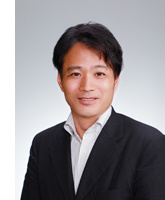
Chief Data Scientist
As the market matures, innovation is becoming more and more important to create new value and for your business to outperform the excessive competition. Amid the situation, many frameworks have emerged to push back the success of innovation without relying on the so-called KKD (Kan; hunch, Keiken; experience, Dokyō; guts) in Japan. But in the bottom line, which framework should you choose? I have summarized the similarities and differences of the following four frameworks based on Nikkei Research's rich experience in using data analysis and frameworks for revealing the customer insights that lead to innovation.
Table 1. The four frameworks introduced in this article
| Framework | Reference | |
|---|---|---|
| 1 | Blue Ocean Strategy | Blue Ocean Strategy: How to Create Uncontested Market Space and Make Competition Irrelevant -- W. Chan Kim, Renee Mauborgne |
| 2 | Jobs Theory (Jobs-to-be-Done) |
Competing Against Luck: The Story of Innovation and Customer Choice -- Clayton M. Christensen, Taddy Hall, Karen Dillon, David S. Duncan |
| 3 | SHIFT | SHIFT: Innovation no sahō -- Hideshi Hamaguchi |
| 4 | 5-Segment/9-Segment Analysis, N1 Analysis |
Tatta hitorino bunseki kara jigyō wa seichō o suru -- Kazuki Nishiguchi |
Two streamlines of innovation frameworks
The four frameworks can be grouped into two separate categories (Figure 1).
- Novelty-driven
- The method that considers "What we do not have in this world" at first, and then under that constraint, extends the idea and design "What benefits to customers".
- Blue Ocean Strategy and SHIFT would be categorized into this.
- Benefit-oriented
- The method that first considers “The benefits to the customer”, and then design “What is novel to the customer”.
- Jobs Theory (Jobs-to-be-Done) and N1 Analysis would be categorized into this.
Let’s take a closer look at each of these frameworks.
Figure 1. Two streamlines of innovation frameworks
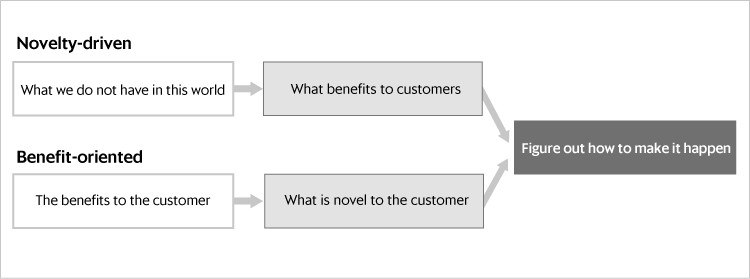
Novelty-driven frameworks (Blue Ocean Strategy, SHIFT)
Both Blue Ocean Strategy and SHIFT start from thinking about something that does not exist today, but there is a difference in the process of getting the hint for innovation.
In the Blue Ocean Strategy, a similar but totally new category is formed by adding four actions (Eliminate, Reduce, Raise, Create) to various elements associated with the product segment. During this process, if you can find customers who feel high value in the elements that you have put into the “Raise/Create” and while pulling out the “Eliminate/Reduce” elements that have high costs, you can create a completely different business model that increases benefits while reducing costs. Two famous examples are the Cirque du Soleil; which has created a new category unlike a traditional circus, and QB House; which has a business model that provides benefits different from those of a traditional barbershop at lower pricing (Table 2).
- Cirque du Soleil has removed the large costs of raising, training, and transporting the animals while strengthening the extraordinary experiences inside the tent and adding thematic and artistic value as entertainment for adults.
- QB House has saved the costs of water facilities by eliminating the hair washing service, but on the other hand, added the benefit of shortening the waiting time and the time spent on haircuts.
Table 2. Examples of Blue Ocean Strategy
| Example | Eliminate, Reduce | Raise | Create |
|---|---|---|---|
| Cirque du Soleil | Shows by animals, Star performers, etc. |
Unique extraordinary tent | Thematic, Artistic |
| QB House | Hair wash, Massage, etc. |
Short waiting time, Short haircut time |
Air washer system |
The other method, SHIFT, first brainstorm and visualize the unconscious assumptions (the bias), and then destroy those biases for the novelty ideation. The USB flash drive is a famous example. When the team were discussing ideas for a next-generation file transferring service, they were biased and couldn’t get out of the box other than the following two; "large files over the internet (Intangible)" and "small files on a media (Tangible)". None came up with the idea of "large files on media" (Figure 2). The question arose; "Is the need to exchange large files via portable media, really zero?” -- leading to an idea for a product that combines flash memory and USB.
Figure 2. Framework of USB memory development
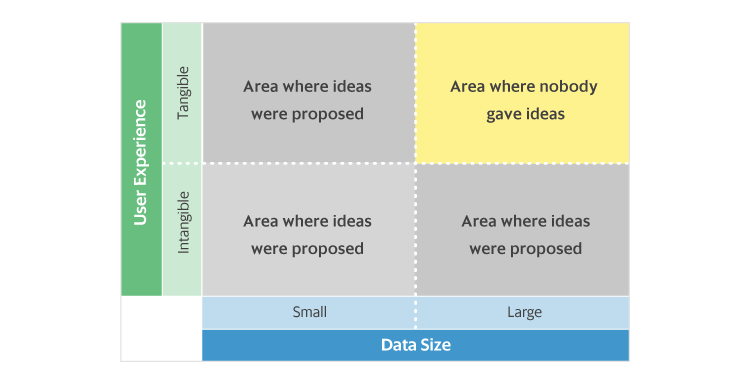 *Figure created by the author based on the referenced books.
*Figure created by the author based on the referenced books.Compared to the Blue Ocean Strategy; which focuses innovation on the narrative of overcoming the cost and value contradiction, SHIFT may not be specific enough and the axes can become very broad with many possible combinations. This is one aspect SHIFT can be difficult to master.
Benefit-oriented frameworks (Jobs Theory, N1 Analysis)
While the Blue Ocean Strategy and SHIFT search for ideas that consumers never dreamed of, Jobs Theory and N1 Analysis start from benefits or inconveniences that already consumers feel.
Jobs Theory thinks from a high-level perspective that is not tied to current product segments. It starts with the question; “What jobs do you want to be done for “hiring” that product?”. For example, margarine --you may want to hire the product for “making the bread moist and easier to chew” or “lubricate the frying pan so the food won’t stick”. If you are looking for something to "moisten", the competitor might be olive oil, mayonnaise, or even corn soup. If it is something that would make food "nonstick" while cooking, then a Teflon-coated nonstick frying pan could be your choice (Figure 3). Thinking about the “jobs” under the circumstances, we can come up with ideas from a distant perspective, far from the competitive market category.
Figure 3. Example of competitors of margarine from the “jobs” perspective
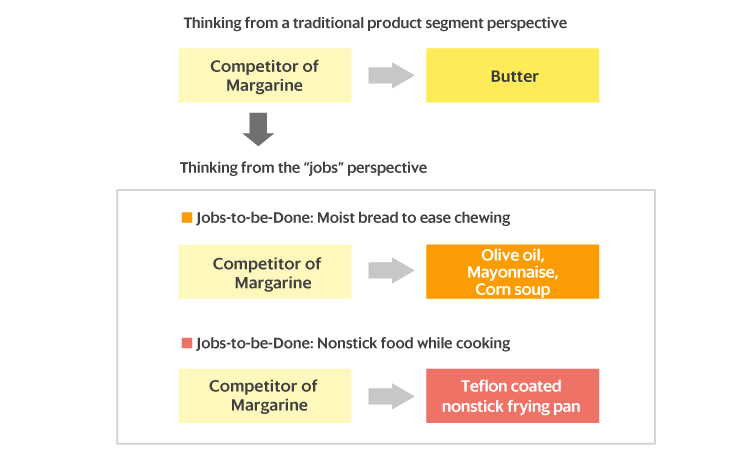
*Figure created by the author based on the referenced books.
N1 analysis is a method of digging down "Why do they choose this product? What do they find beneficial about it?”, based on the understanding of each individual’s background. The 5-Segment/9-Segment Analysis , which classify your customers and competitor’s customers by frequency of purchase and intention to repeat, can extract ideas based on hints from "benefits that only loyal customers are aware of" and "benefits that attract non-buyers who had little interest in the service”. Once the seeds of ideas are found, the next step would be to examine "How much potential does this idea have in motivating other segments?". It helps us consider both the targets and the measures to be taken as a whole. In the case of Rohto Pharmaceutical’s "Hada Labo”, a customer’s voice referring to the sticky feeling when using the product as “the proof of moisturizing”, led to the idea of “Facial lotion that makes your skin so glutinous, your hands won’t come off from your cheek! (A “mochi skin” experience)” (Figure 4).
Figure 4: Example of the facial lotion "Hada Labo” idea discovery
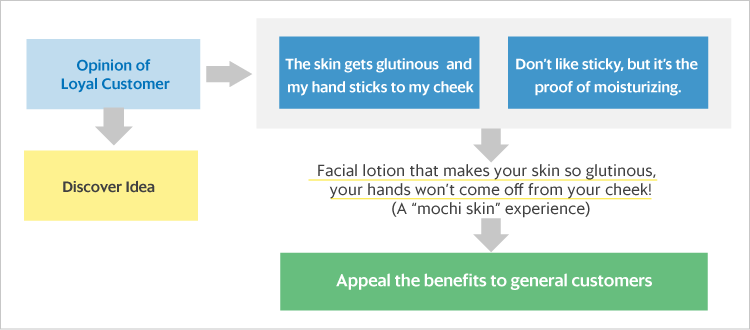
*Figure created by the author based on the referenced books.
Jobs theory and N1 analysis are both focusing on the essential question; "Why do they buy / choose?”, and from the deep understanding of each individual customer, derive ideas and deploy into tactics.
While the Jobs Theory having a high-level perspective, it might be able to provide unexpected ideas that are not bound to general categories, but it can be difficult to come up with actionable tactics from the jobs discovered. On the other hand, N1 analysis combined with 5-Segment/9-Segment Analysis, explores ideas for motivating customers from one segment to another, resulting in the extracted ideas to be actions bundled with targets, making it easier to deploy as marketing programs.
Conclusion: Summarizing and positioning the four frameworks
We positioned the four frameworks regarding the two axes; "Share of people on the provider side who are aware of the benefits" and "Share of people on the customer side who are aware of the benefits".
Figure 5. Perception rate of benefits: [Provider side] vs [Customer side]
![Figure 5. Perception rate of benefits: [Provider side] vs [Customer side]](https://www.nikkei-r.co.jp/hubfs/Imported_Blog_Media/C7868-05-1.png) *Figure created by the author.
*Figure created by the author.In this context, Jobs Theory and 5-Segment/9-Segment Analysis + N1 Analysis focus on similar customer groups (i.e., Jobs Theory: customers who are in the same situation. | N1 analysis: customers who have the same frequency of purchase and intention to continue in the result of 5-Segment/9-Segment Analysis), and then dive into the cause individually. If it divides customers into groups based on some axis, it becomes closer to Marketing 2.0. If it considers the value proposition through understanding customers as individuals, it becomes closer to Marketing 3.0.
In contrast, Blue Ocean Strategy and SHIFT are different from conventional marketing theories in terms of their starting points, as they start from an area that neither the company nor the customer was aware of. After the primary ideation, you will design the benefits of the customer and the business model’s feasibility, which is common to the other methods. However, because those focus and aim to come up with a novelty output, it is much difficult to convince the value to both the company internally and to customers, compared to Jobs Theory or N1 Analysis.
The process differs between the four frameworks discussed in this article, but all of them will be considering both novelty and benefits with several axes in the end. Therefore, the same idea might surface by using any of those frameworks.
If you want to explore something more unexpected, use…
- SHIFT
- Blue Ocean Strategy
- 5-Segment/9-Segment Analysis + N1 Analysis
- Jobs Theory
In this article, I have compared and categorized the four innovation frameworks by focusing on the starting perspective. The books in Table 1 have detailed explanations with examples on what axes you should use for ideation and how to run workshops. If you are interested in any of the frameworks, those books are worth a read.
If you are interested in further details, please contact us below.
please contact us below.
